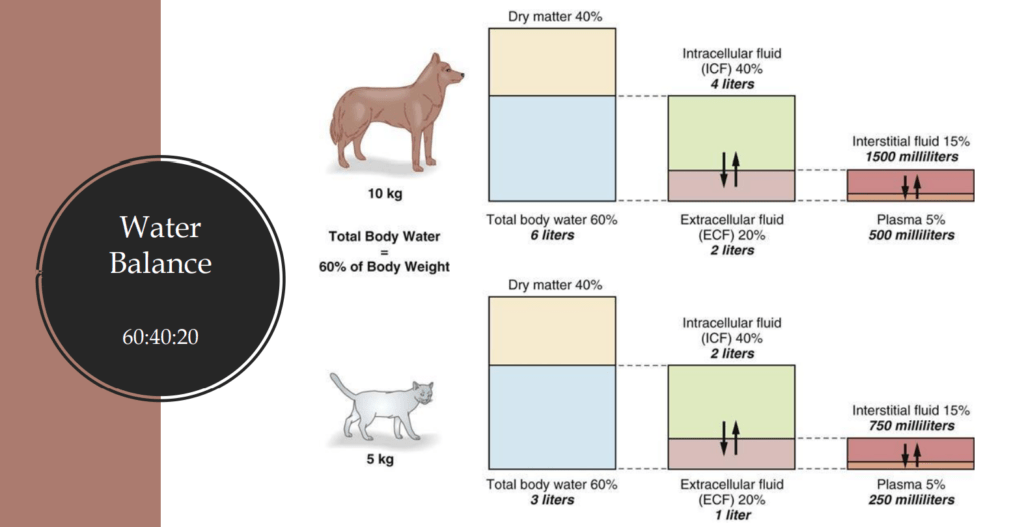TABLE OF CONTENTS
Fluid therapy
Fluid therapy in animals refers to administration of fluids to compensate the loss of fluids from the body due to a variety of conditions leading to dehydration. Fluid loss in the body can lead to shock and can become fatal if unattended to.
Definition of fluid therapy
Replenishing the body fluid lost through sweating, bleeding or other pathological processes
The purpose of fluid therapy is to correct dehydration or overhydration, elctrolyte imbalance and /or acid -base imbalance.
Fluid therapy in animals is also indicated to correct acidosis/alkalosis, treat shock, give parenteral nourishment or even stimulate organ function such as kidney.

Fluid volume and type
The type of solution is to be dictated by history, clinical signs and laboratory examination. The volume of fluid is determined the need for maintenance as well as the need for replacement of lost fluid.
For normal maintenance, a thumb rule of 65 ml / kg /24 hrs. for adults and 130 ml / kg /24 hrs. for young ones is calculated. based on this, a normal mature dog of 20 kg would require 1300 ml for 24hr period.
Replacement of fluid loss must be in addition to the maintenance requirement. to calculate fluid loss one must estimate the degree of dehydration.
Degree of Dehydration
| Degree of dehydration | Clinical signs |
| 4% | history of fluid loss, leathery skin, mucous membrane still moist and evidence of thirst |
| 6% | skin still leathery, when lifted the skin will peak and return to normal slowly, hair coat dull,mucous membrane dry but the tongue still moist |
| 8% | skin will show lack of pliability and elasticity, the skin loses turgor (when lifted will peak and stay, mucous membrane and tongue dry, eyeballs will be soft and sunken. |
| 12% | Signs of circulatory collapse |
| 15% | Symptoms of Acute shock |
Fluid volume to replace
The volume of fluid to replace loss of fluid is calculated by the body weight multiplied by degree of dehydration. For example a dog weighing 20 kg with 6% dehydration is given 20 kg x 0.06 – 1200 ml or 1.2 liters.
This is apart from the maintenance requirement of 20 x 65 = 1300 ml.
Rates and administration of fluid therapy
The rate of replacement of fluids should parallel the severity of dehydration. Fluids should be administered rapidly at first followed by decreasing rates. Most commonly it is agreed that 15 ml / kg / hr is a reasonable rate. In severely dehydrated cases this can go up to 50 ml / kg /hr. Higher rates can overload the system and may even cause overhydration.
Route of administration of fluid
The route depends on the type of illness, severity, degree of dehydration, patient condition, time and equipment available.
The most common and overlooked one is the oral or nasogastric. It is the least dangerous, without strict asepsis.
Per rectal administration can also be considered. It may be difficult to retain the fluid especially in the presence of gastrointestinal disease.
The IV route is the most versatile. It is indicated for emergencies, severe cases. It has the advantage of large volume of administration. But maintenance of indwelling catheter, clotting and hematoma and location of vein are some of the drawbacks.
The SC route is handy in cases of small animals where larger volumes need to be give but it is difficult to locate the vein. It is irritating and can be painful .Fluid absorption is more slow. IP route also suffers form the drawback of easy predisposition to peritonitis.
Choice of fluid
Proper selection of fluid begins by determining the type of deficit and choice of fluids-Colloid, crystalloid or combination of both.
Crystalloid and Colloid type of fluids
Crystalloids
Water based solution with small particles that are normally osmotically active in body fluids and can pass through capillary membrane, commonly used for fluid therapy.
Colloids
Large particles that do not readily leave the intravascular space, but attract and hold water in vascular space thereby expanding vascular volume and exert osmotic pressure in a manner similar to that of plasma proteins.
| Fluid | Indications |
| Isotonic saline (Normal saline, 0.9%) | To correct metabolic acidosis, especially after vomiting |
| Isotonic dextrose saline (0.18% NaCl + 4.3% Dextrose) | Maintenance therapy, hypertonic dehydration |
| Darrow’s solution (0.4% NaCl + 0.27% KCl + 0.58% Sodium lactate) | Metabolic acidosis associated with diarrheal dehydration and potassium loss |
| 5% Dextrose | Hypertonic dehydration resulting from water deprivation or heat stroke; used in emergency to provide transient alleviation of hypoglycaemia |
| Compound Sodium Lactate (Hartmann’s solution or Ringer’s lactate) | Metabolic acidosis, Replacement of losses owing to gastrointestinal dysfunction (vomiting, diarrhea), haemorrhage, burns |
| Dextrose Saline (0.9% NaCl + 5% Dextrose) | For emergency treatment of dehydration and hypoglycaemia |
| Sodium bicarbonate (1.3%) | Severe Acidosis |
| Whole blood | Replacement for blood loss in treating anaemia |
| Plasma expanders | |
| Dextran | Effective in restoration of blood volume in cases of hemorrhage or shock. |
| Gelatin colloidal solution | Hypovolemic shock, burns, blood loss and diarrhea |
Choice of fluid based on clinical conditions
| Clinical Condition | Choice of fluid |
| Vomiting | Normal Saline Dextrose Saline Ringer’s solution |
| Diarrhea | Lactated Ringer’s Darrow’s fluid (In chronic cases with K+ loss) |
| Bowel obstruction | Lactated Ringer’s (+ colloid for shock) |
| Hemorrhage | Whole blood Lactated Ringer’s Colloid |
| Peritonitis | Colloid Lactated Ringer’s |
| Shock | Dextran + Hartmann’s Ringer’s Lactate Gelatin Colloid |